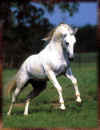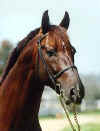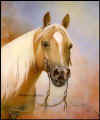|
Everything you need to successfully ride, own, or be a horse in a roleplay
game. [in progress]
Intro: Horses are beautiful and athletic animals that have been domesticated
for thousands of years. They come in over 200 breeds, ranging from 7 hh (about
28") to 19 hh (76"). Some are shorter, some are smaller. Generally,
horses can carry up to 20% of their body weight. A 15.0 hh horse will generally
weigh 1000 lbs, so they could carry at most 200 lbs. This is a gross
generalization, but you get the point.
Horses can run very fast, sometimes as fast as 30 or so mph. This can only be
achieved over a very short distance, and only a few horses are capable of such
speeds. Exceptional jumpers can jump regularly as high as 5'5", but most
jump around 3' with no problem. Most horses cannot leap fences in a single
bound.
Horse Heights are measured at the shoulder, called the withers. This is the
highest point when the head is down. 14.2 hh and above is considered horse
height, and 14.1 hh and below is considered pony height. These are
generalizations, as there are 14.1 hh horses and 14.3 hh ponies, but we won't go
there. \
Colors:
Horses come in several colors. Several are described. (PS> There is no
white horse)
|

|
True Black: Also called blue-black, this is the actual shade, not a brown.
True black mane and tail, and around the muzzle and other exposed skin is
black as well. (Friesian) |
|

|
Grey: Black skin with white hairs. The area between the legs (under the
tail) and around the muzzle and eyes is usually black, and the hair can
range from almost white to a steel grey. Dapples may be present.
(Andalusian) |
|

|
Bay: Reddish-brown coat with black points (muzzle, mane, tail, and legs).
May be very dark, almost brown (seal bay or black bay), or may be very
bright (blood bay). (Irish Draught) |
 |
Chesnut: Brown coat, brown mane, and brown tail. May be reddish brown
(sorrel) or may be very dark brown or chocolate (liver chesnut) (Oldenburg) |
|

|
Palomino: Dilute of the chesnut gene. A creamy tan color with white
mane and tail. May be new-copper-penny colored or light cream.
(Chocolate Palomino: Liver chesnut with white mane and tail and dark
brown legs) (Quarter Horse) |
 |
Buckskin: Dilute of the bay gene. A yellowish color with black points
(mane, tail, legs) (Quarter Horse) |
| picture coming soon |
Dun: a pale yellowish/reddish
color, with the points relatively the same color as the body. Duns often
have a stripe running down their spine, called a dorsal stripe, and
sometimes 'zebra stripes' on the lower legs. |
 |
Red Roan: Roans are bays and
chesnuts with a sprinkling of white hairs throughout. The bay and chesnut
variety is considered a red or strawberry roan. (Quarter Horse) |
 |
Blue Roan: Same concept as the
red roan, only with a black base coat instead of bay or chesnut. (Quarter
Horse) |
There are different types of horses for different purposes. Desert horses are
different from knights' horses are different from ladies' horses. Each has a
specific usage that they were bred for.
Desert horses usually come in about three varieties: Arabian, Barb (or
Barbary) and Turk (or Turkamene). These horses were bred in or about Arabia, by
various nomadic tribes. They were highly prized, and stallions were never sold.
They may be given or traded, but never sold. They are very refined, athletic,
and have excellent stamina and endurance. They are known for their beautifully
chiseled head and arched neck, as well as their high-set tail. Barbs and Turks
are similar in many ways to the Arabian, but if you want to appear as authentic
as possible, I suggest just sticking with the arabian. The two strains of
Arabian (there are many, everything from Spanish to Polish to Russian to
Egyptian) are the Shagya Arabians and the Al Khasma Egyptian Arabians. Usually
standing anywhere from 14.2 hh (4'10") to 16.1 (5'5"), they may be
slightly taller but you'd be *extremely* unlikely to find even a 16.2 hh
Arabian or Desert horse.
|

|
Egyptian Arabian--- note the dished head and the arched neck. Compare
to other pictures on this page. |
 |
Friesian--- note the heavy build, feathered legs, and
compact body. Compare to the Arabian and other pictures. |
Medieval horses were radically different. Different types or grades of horses
looked different than one another.
| Friesians: (Badhbh
Catha)
Medieval horses differ greatly in appearance from their thin
boned, hot blooded relatives. Most medieval war horses can trace
their bloodlines back to the classical Spanish Andalusian, a very influential
breed for most European warmbloods. The epitome of a medieval war
steed is the Friesian, an impressive horse originating from
Friesland, the Netherlands. The Friesian is noted for it's heavy
feathered fetlocks, low set tail, large head, high-set, arching neck
and jet black coloration. In fact black, or bay-black is the only
coloration allowed in the breed, and no markings other than a few
white hairs upon the forehead are permitted. Friesians are known for
their long luxurious manes, tails and 'feathers' which are never
shaved or trimmed. Although heavier and more draft-like than most
warmbloods, the Friesian is agile and versatile, used quite
successfully for riding and driving. Their heavy build and powerful
limbs accompanied by their calm, easy going temperament made them
the ideal knights mount. Their stride is large and gaits smooth,
although they prefer the trot, which they have been bred for, to the
canter. Although they may appear larger because of their high set,
arched neck, the Friesian averages 15.3hh though they may extend
from 14.3hh to 17hh. I have found the most common misconception is
that Friesians are often portrayed in RPG's as hot, temperamental
horses. They are actually quite the opposite, being much calmer and
easy going than their desert relatives, but retaining their
impressive movement. Good war horses remained calm in battle but
were responsive to their rider's aids, allowing the knight to keep
his full attention upon his opponent. |
|
|
|








